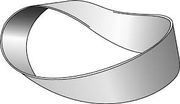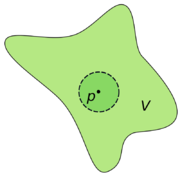m |
|||
| (11 intermediate revisions by 2 users not shown) | |||
| Line 1: | Line 1: | ||
==Topology== | ==Topology== | ||
| − | Topology is a branch of mathematics that studies how geometric properties are preserved throughout continuous deformations. Continuous deformations are things such as stretching, bending, and twisting; they are not deformations such as gluing and cutting. | + | Topology is a branch of mathematics that studies how geometric properties are preserved throughout continuous deformations. Continuous deformations are things such as stretching, bending, and twisting; they are not deformations such as gluing and cutting. A common object in the study of topology is the Möbius strip. |
| + | [[File:Mobius_Strip.jpg|thumb|Möbius Strip]] | ||
| − | One of the first terms necessary to understanding topology is a set. A set is an object that consists of defined and distinct objects. That is to say that elements of a set are different from each other. Since a set is an object and it is made of objects, a set may consist of other sets. Important concepts associated with sets include open sets, closed sets, and bounded sets. The important distinction in topology between open and closed sets is that a closed set includes all of its limit points whereas an open set does not. Limit points are those such that a limit point P of set S is such that every possible open set around P contains at least one other point of S. A set is bounded essentially if it is of finite size. For a set to be bounded, there must be a corresponding metric to the set. | + | One of the first terms necessary to understanding topology is a set. A set is an object that consists of defined and distinct objects. That is to say that elements of a set are different from each other. Since a set is an object and it is made of objects, a set may consist of other sets. Important concepts associated with sets include open sets, closed sets, and bounded sets. The important distinction in topology between open and closed sets is that a closed set includes all of its limit points whereas an open set does not. Limit points are those such that a limit point P of set S is such that every possible open set around P contains at least one other point of S. A set is bounded essentially if it is of finite size. For a set to be bounded, there must be a corresponding metric to the set. Two additional important terms regarding sets are subsets and supersets. If all elements of set A are a elements of set B, we call A a subset and B a superset. The empty set <math>{\displaystyle \emptyset}</math> is the set that contains no elements. |
| − | + | An important topic of sets to understand is that of measure. A measure is a way to assign values to subsets of a set. The simplest way to understand this is size. This measure, called the Lebesgue measure, associates length, area, and volume to sets in R<sup>1</sup>, R<sup>2</sup>, and R<sup>3</sup> respectively. | |
| − | The next topic to understand in topology is that of a topological space. In a general understanding, a topological space is a set of points and a corresponding set of neighborhoods. A topological space also must satisfy a set of axioms (conditions) that relate the points and the neighborhoods. | + | Another fundamental term for understanding topology is neighborhood. This can largely be understood using the common knowledge of what a neighborhood is. In terms of topology, a neighborhood of a point P is a set of points that contains P in which you can move in a small amount in any direction and not leave the set. That is to say, a neighborhood of a point is an area around a point that is within the larger set. |
| + | [[File:Neighborhood.png|thumb|V is a neighborhood of point P]] | ||
| + | |||
| + | The next topic to understand in topology is that of a topological space. In a general understanding, a topological space is a set of points and a corresponding set of neighborhoods. A topological space also must satisfy a set of axioms (conditions) that relate the points and the neighborhoods. There are two main ways to define a topological space, the most common being in terms of open sets and the easier (and more relevant to the topic at hand) is through neighborhoods. This definition was given by Felix Hausdorff. His definition is as follows: Let X be a set, X can be a set of any mathematical objects but it is most easily understood through points. N is a function that assigns each element x of X to a non-empty collection of subsets of X called N(x). The elements of N(x) can be called neighborhoods. N is called a neighborhood topology if the following axioms are met: | ||
| + | 1. Each point is a part of each of its associated neighborhoods. In other terms, if ''N''εN(x), then xε''N''. | ||
| + | 2. Every possible superset of a neighborhood of point x is also a neighborhood of point x. | ||
| + | 3. The intersection of neighborhoods of x is also a neighborhood of x. | ||
| + | 4. Every neighborhood of x contains an open set that is also a neighborhood of x. | ||
| + | Furthermore, a topological space is called a Hausdorff space or a separated space if it meets the following axiom: If points x and y are in a topological space X, there must be a neighborhood A for point X and a neighborhood B for point y such that A and B are disjoint, in other words <math>{\displaystyle A\cap B=\emptyset }</math> or A and B do not overlap. | ||
| + | |||
| + | A topological space is defined as locally compact if, generally, each small piece of the space is similar to a small piece of compact space. Compactness is a property that combines both being closed and being bounded. | ||
| + | |||
| + | A topological group is a group that is also a topological space that meets the conditions of the group's binary operation being continuous and the function that maps elements to their inverses being continuous. | ||
| + | |||
| + | [[ Walther MA271 Fall2020 topic18|Back to Walther MA271 Fall2020 topic18]] | ||
| + | |||
| + | [[Category:MA271Fall2020Walther]] | ||
Latest revision as of 01:03, 7 December 2020
Topology
Topology is a branch of mathematics that studies how geometric properties are preserved throughout continuous deformations. Continuous deformations are things such as stretching, bending, and twisting; they are not deformations such as gluing and cutting. A common object in the study of topology is the Möbius strip.
One of the first terms necessary to understanding topology is a set. A set is an object that consists of defined and distinct objects. That is to say that elements of a set are different from each other. Since a set is an object and it is made of objects, a set may consist of other sets. Important concepts associated with sets include open sets, closed sets, and bounded sets. The important distinction in topology between open and closed sets is that a closed set includes all of its limit points whereas an open set does not. Limit points are those such that a limit point P of set S is such that every possible open set around P contains at least one other point of S. A set is bounded essentially if it is of finite size. For a set to be bounded, there must be a corresponding metric to the set. Two additional important terms regarding sets are subsets and supersets. If all elements of set A are a elements of set B, we call A a subset and B a superset. The empty set $ {\displaystyle \emptyset} $ is the set that contains no elements.
An important topic of sets to understand is that of measure. A measure is a way to assign values to subsets of a set. The simplest way to understand this is size. This measure, called the Lebesgue measure, associates length, area, and volume to sets in R1, R2, and R3 respectively.
Another fundamental term for understanding topology is neighborhood. This can largely be understood using the common knowledge of what a neighborhood is. In terms of topology, a neighborhood of a point P is a set of points that contains P in which you can move in a small amount in any direction and not leave the set. That is to say, a neighborhood of a point is an area around a point that is within the larger set.
The next topic to understand in topology is that of a topological space. In a general understanding, a topological space is a set of points and a corresponding set of neighborhoods. A topological space also must satisfy a set of axioms (conditions) that relate the points and the neighborhoods. There are two main ways to define a topological space, the most common being in terms of open sets and the easier (and more relevant to the topic at hand) is through neighborhoods. This definition was given by Felix Hausdorff. His definition is as follows: Let X be a set, X can be a set of any mathematical objects but it is most easily understood through points. N is a function that assigns each element x of X to a non-empty collection of subsets of X called N(x). The elements of N(x) can be called neighborhoods. N is called a neighborhood topology if the following axioms are met:
1. Each point is a part of each of its associated neighborhoods. In other terms, if NεN(x), then xεN. 2. Every possible superset of a neighborhood of point x is also a neighborhood of point x. 3. The intersection of neighborhoods of x is also a neighborhood of x. 4. Every neighborhood of x contains an open set that is also a neighborhood of x.
Furthermore, a topological space is called a Hausdorff space or a separated space if it meets the following axiom: If points x and y are in a topological space X, there must be a neighborhood A for point X and a neighborhood B for point y such that A and B are disjoint, in other words $ {\displaystyle A\cap B=\emptyset } $ or A and B do not overlap.
A topological space is defined as locally compact if, generally, each small piece of the space is similar to a small piece of compact space. Compactness is a property that combines both being closed and being bounded.
A topological group is a group that is also a topological space that meets the conditions of the group's binary operation being continuous and the function that maps elements to their inverses being continuous.



